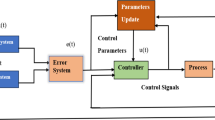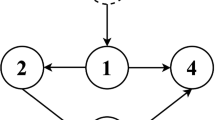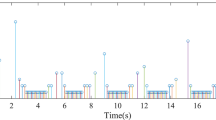Abstract
A state estimation problem is studied for a class of coupled outputs discrete-time networks with stochastic measurements, i.e., the measurements are missing and disturbed with stochastic noise. The considered networks are coupled with outputs rather than states, are coupled with different inner coupling matrices rather than identical inner ones. By using Lyapunov stability theory combined with stochastic analysis, a novel state estimation scheme is proposed to estimate the states of discrete-time complex networks through the available output measurements, where the measurements are stochastic missing and are disturbed with Brownian motions which are caused by data transmission among nodes due to communication unreliability. State estimation conditions are derived in terms of linear matrix inequalities (LMIs). A numerical example is provided to demonstrate the validity of the proposed scheme.
Similar content being viewed by others
References
X.-F. Wang and G. Chen, “Synchronization in small-world dynamical networks,” International Journal of Bifurcation and Chaos, vol. 12, no. 1, pp. 187–192, 2002.
A. L. P. Y. Piontti, P. A. Macri, and L. A. Braunstein, “Discrete surface growth process as a synchronization mechanism for scale-free complex networks,” Physical Review E, vol. 76, no. 4, p. 046117, 2007.
Y. Tang and J. A. Fang, “Synchronization of Taka gi-Sugeno fuzzy stochastic delayed complex networks with hybrid coupling,” Modern Physics Letters B, vol. 23, no. 20–21, pp. 2429–2447, 2009.
L. Chen, L. Wu, and S. Zhu, “Synchronization in complex networks by time-varying couplings,” European Physical Journal D, vol. 48, no. 3, pp. 405–409, 2008.
N. Mahdavi and M. B. Menhaj, “A new set of sufficient conditions based on coupling parameters for synchronization of Hopfield chaotic neural networks,” International Journal of Control, Automation, and Systems, vol. 9, no. 1, pp. 104–111, 2011.
M. Chavez, D. U. Hwang, and S. Boccaletti, “Synchronization processes in complex networks,” European Physical Journal-Special Topics, vol. 146, pp. 129–144, 2007.
T. Li, T. Wang, A.-G. Song, and S.-M. Fei, “Exponential synchronization for arrays of coupled neural networks with time-delayed couplings,” International Journal of Control, Automation, and Systems, vol. 9, no. 1, pp. 187–196, 2011.
M. Y. Chen, “Some simple synchronization criteria for complex dynamical networks,” IEEE Trans. on Circuits and Systems Ii-Express Briefs, vol. 53, no. 11, pp. 1185–1189, 2006.
Y. Dai, Y. Z. Cai, and X. M. Xu, “Synchronization criteria for complex dynamical networks with neutral-type coupling delay,” Physica A-Statistical Mechanics and Its Applications, vol. 387, no. 18, pp. 4673–4682, 2008.
Y. Liu, Z. Wang, J. Liang, and X. Liu, “Synchronization and state estimation for discrete-time complex networks with distributed delays,” IEEE Trans. on Systems, Man and Cybernetics — Part B: Cybernetics, vol. 38, no. 5, pp. 1314–1324, 2008.
J. Liang, Z. Wang, and X. Liu, “State estimation for coupled uncertain stochastic networks with missing measurements and time-varying delays: the discrete-time case,” IEEE Trans. on Neural Networks, vol. 20, no. 5, pp. 781–793, 2009.
G. J. Wang, J. D. Cao, and J. Q. Lu, “Outer synchronization between two nonidentical networks with circumstance noise,” Physica A-Statistical Mechanics and Its Applications, vol. 389, no. 7, pp. 1480–1488.
X. Q. Wu, W. X. Zheng, and J. Zhou, “Generalized outer synchronization between complex dynamical networks,” Chaos, vol. 19, no. 1, p. 013109, 2009.
G. P. Jiang, W. K. S. Tang, and G. R. Chen, “A state-observer-based approach for synchronization in complex dynamical networks,” IEEE Trans. on Circuits and Systems I-Regular Papers, vol. 53, no. 12, pp. 2739–2745, 2006.
C.-X. Fan, G.-P. Jiang, and F.-H. Jiang, “Synchronization between two complex dynamical networks using scalar signals under pinning control,” IEEE Trans. on Circuits and Systems -I: Regular Papers, vol. 57, no. 11, pp. 2991–2998, 2010.
A. Alessandri, C. Cervellera, D. Maccio, and M. Sanguineti, “Optimization based on quasi-Monte Carlo sampling to design state estimators for nonlinear systems,” Optimization, vol. 59, no. 7, pp. 963–984, 2010.
M. Mojiri, D. Yazdani, and A. Bakhshai, “Robust adaptive frequency estimation of three-phase power systems,” IEEE Trans. on Instrumentation and Measurement, vol. 59, no. 7, pp. 1793–1802, 2010.
D. Kang and K. Lansey, “Real-time demand estimation and confidence limit analysis for water distribution systems,” Journal of Hydraulic Engineering-Asce, vol. 135, no. 10, pp. 825–837, 2009.
C. Lin, Z. D. Wang, and F. W. Yang, “Observerbased networked control for continuous-time systems with random sensor delays,” Automatica, vol. 45, no. 2, pp. 578–584, 2009.
F. W. Yang, W. Wang, V. G. Niu, and V. M. Li, “Observer-Based H-infinity control for networked systems with consecutive packet delays and losses,” International Journal of Control Automation and Systems, vol. 8, no. 4, pp. 769–775, 2010.
S. Boyd, L. E. Ghaoui, E. Feron, and V. Balakrishnan, Eds., Linear Matrix Inequalities in System and Control Theory, Society for Industrial and Applied Mathematics, Philadelphia, 1994.
Author information
Authors and Affiliations
Corresponding author
Additional information
Recommended by Editorial Board member Yuan Fang Zheng under the direction of Editor Zengqi Sun.
This work is partially supported by Research Development & Incentives Program of Central Queensland University under Merit Grant RSH/2028, National Natural Science Foundation of China under Grant 61174064 and 61104103, National Program on Key Basic Research Project (973 Program) under Grant 2012CB720500, the Natural science fund for colleges and universities in Jiangsu Province under Grant 10KJB120001, and the Climbing Plant of Nanjing University of Posts & Telecommunications under Grants NY210013 and NY210014.
Chun-Xia Fan received her B.Sc. degree in Electrical Technology from Changchun University, Changchun, China, an M.Sc. degree in Basic Mathematics from Guizhou University, Guiyang, China, and a Ph.D. degree in Control Theory and Control Engineering form Nanjing University of Aeronautics And Astronautics, Nanjing, China, in 1995, 2001, 2005, respectively. From 2004, she joined the College of Automation, Nanjing University of Posts & Telecommunications, Nanjing, China, where she is currently an associate professor. Her research interests include complex network theory with its applications and networked control.
Fuwen Yang is currently a Senior Research Fellow in the Centre for Intelligent and Networked Systems, Central Queensland University, Australia. Before joining Central Queensland University, he was a Professor at East China University of Science and Technology and Fuzhou University, China. He also held several research positions at King’s College London, U.K., Brunel University, U.K., the University of Manchester, U.K., and the University of Hong Kong, Hong Kong. His research interests include H-infinity control and filtering, networked control, fault detection and diagnosis, signal processing, industrial real-time control, and power electronics.
Ying Zhou was born in 1978. She received her Ph.D. degree in Automatic Control from Southeast University, China in 2007. She now is an associate professor in the College of Automation at Nanjing University of Posts and Telecommunications, Nanjing. Her research interests include networked control, H-infinity control and adaptive control.
Rights and permissions
About this article
Cite this article
Fan, CX., Yang, F. & Zhou, Y. State estimation for coupled output discrete-time complex network with stochastic measurements and different inner coupling matrices. Int. J. Control Autom. Syst. 10, 498–505 (2012). https://doi.org/10.1007/s12555-012-0306-8
Received:
Revised:
Accepted:
Published:
Issue Date:
DOI: https://doi.org/10.1007/s12555-012-0306-8




